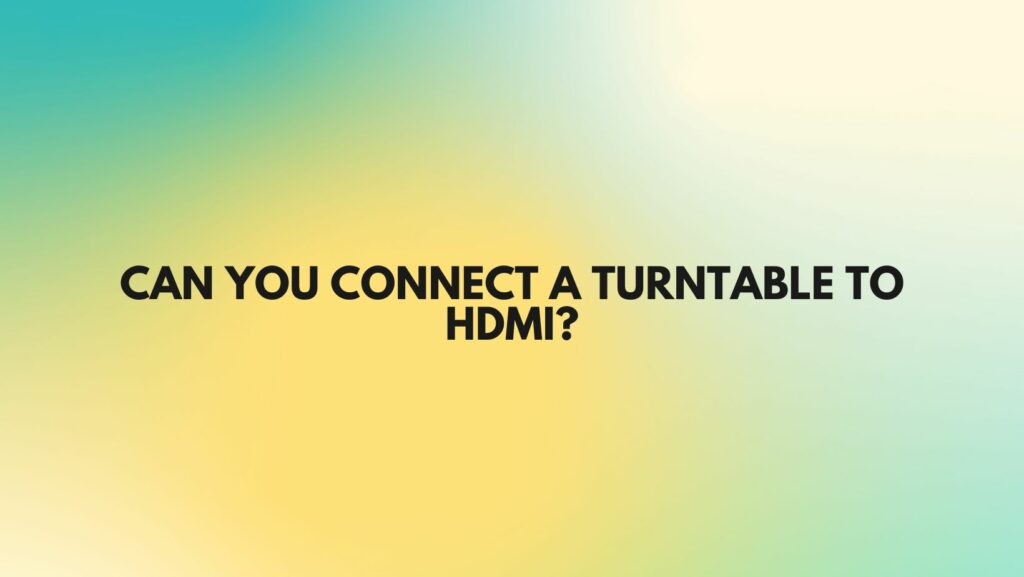In today’s rapidly evolving digital age, the integration of analog devices with modern technology has become a common practice. Turntables, which are iconic analog devices used for playing vinyl records, have also found their place in this digital world. Many enthusiasts and audiophiles wonder if it’s possible to connect a turntable to an HDMI interface, which is primarily associated with high-definition video and audio transmission. In this article, we’ll explore the various methods and devices that can help you connect a turntable to HDMI and the potential benefits of doing so.
Understanding the Basics
Before delving into the details of connecting a turntable to HDMI, it’s essential to understand the primary components involved:
- Turntable: A turntable, often referred to as a record player, is a device that plays vinyl records. It converts the analog information on the records into audible sound using a stylus and a cartridge.
- HDMI (High-Definition Multimedia Interface): HDMI is a standard for transmitting high-definition audio and video signals over a single cable. It’s commonly used in home theaters, gaming consoles, televisions, and other multimedia devices.
- Analog to Digital Conversion: To connect a turntable to HDMI, you’ll need a device that can convert the analog audio signal from the turntable into a digital format compatible with HDMI.
Methods for Connecting a Turntable to HDMI
- Turntable with Built-in Preamp:
Some modern turntables come with a built-in preamp. A preamp (phono preamplifier) is essential for amplifying the low-level signal produced by the turntable’s cartridge. If your turntable has a built-in preamp, you can connect it directly to an HDMI-enabled device, like an HDMI audio extractor, which can then send the audio signal via HDMI to your TV or home theater system.
- Using an External Phono Preamp:
If your turntable doesn’t have a built-in preamp, you will need to use an external phono preamp. Connect the turntable to the phono preamp and then connect the preamp’s output to an HDMI audio extractor. The HDMI extractor can convert the analog audio signal into a digital format compatible with HDMI.
- Turntable to AV Receiver:
An alternative method is to connect your turntable to an AV receiver equipped with HDMI inputs. Most AV receivers include phono preamps. The turntable connects to the receiver, and the receiver can then route the audio signal to your HDMI-equipped TV or projector.
- Turntable to a USB Audio Interface:
You can connect your turntable to a USB audio interface with analog inputs. The USB audio interface converts the analog audio signal to a digital format that can be connected to a computer or other HDMI-enabled devices through a USB connection.
Benefits of Connecting a Turntable to HDMI
- Enhanced Audio Quality: HDMI offers high-quality audio transmission, allowing you to enjoy your vinyl records with clear and crisp sound. This can be especially beneficial when using a high-end audio setup.
- Integration with Modern Systems: By connecting your turntable to HDMI, you can easily integrate it into your home theater or multimedia setup, making it convenient to switch between vinyl records and digital content.
- Simplified Connectivity: Using HDMI simplifies the connection process, eliminating the need for multiple cables and adapters.
- Digital Archiving: If you use a USB audio interface, you can digitize your vinyl collection, preserving your records in a digital format for convenient playback and archiving.
Conclusion
While the primary purpose of HDMI is to transmit high-definition video and audio, it is possible to connect a turntable to HDMI-enabled devices using various methods. Whether your turntable has a built-in preamp, you use an external phono preamp, or connect it to an AV receiver, HDMI can provide an excellent solution for enjoying your vinyl records in the digital age.
Connecting a turntable to HDMI not only enhances audio quality but also simplifies connectivity and allows for the integration of vinyl playback into modern multimedia setups. This flexibility ensures that vinyl enthusiasts can continue to enjoy their analog treasures while benefiting from the convenience and quality offered by HDMI technology.

